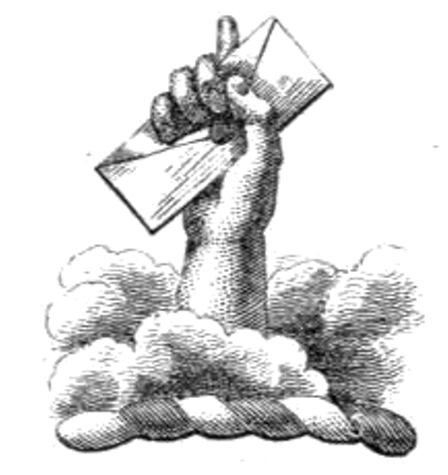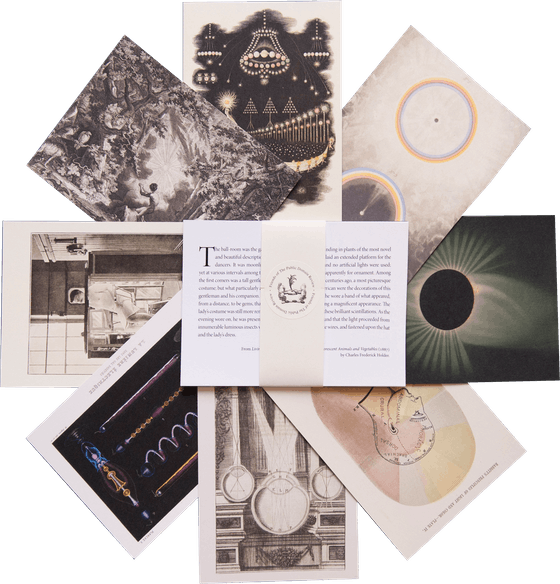
Dancing Naked on the Head of a Pin The Early History of Microphotography
In 1853, John Benjamin Dancer achieved a feat of seemingly impossible scale: he shrunk an image to the size of a sharpened pencil tip. Anika Burgess explores the invention of microphotography and its influence on erotic paraphernalia and military communications.
June 18, 2025
An erotic Stanhope microphotograph from Alfred Kinsey’s collection, ca. 1920s — Source.
The early photographs known as daguerreotypes were once available in a range of standard sizes.1 The largest was known as the “whole plate” daguerreotype, and it measured 6.5 by 8.5 inches. From there, the sizes decreased — half-plate, quarter-plate, and so on — until you reached the smallest, the diminutive sixteenth-plate size. This measured about 1.4 by 1.6 inches, roughly the size of a passport photo. So you can imagine the astonishment when one photographer, based in Liverpool, reduced a daguerreotype using a microscope lens to the tiny size of an eighth of an inch, or three millimeters.2
The photographer was an enthusiastic amateur who had traveled all the way to London in late 1839 to see Louis Daguerre’s extraordinary new process for himself. He was in his mid-twenties, and working as an optical instrument manufacturer, selling items such as spectacles and microscopes; once he returned from London, he also began to sell daguerreotype cameras. His name was John Benjamin Dancer.3
Microphotography hit its stride with the wet collodion process, a way of coating glass to make it light sensitive, and Dancer was at the forefront of these experiments. (Microphotography, the photography of regular-sized objects in minuscule format, is separate from photomicrography, photographs taken through a microscope of the otherwise tiny and invisible — the hairs on a flea, for example.) In April 1853, Dancer, now based in Manchester, took a standard four-by-five-inch photo of a newly completed memorial plaque for the inventor William Sturgeon.4 The plaque held nineteen lines of text, 680 letters in total. Dancer reduced his photo’s size to one-sixteenth of an inch, or approximately one-and-a-half millimeters. That’s only slightly larger than the point of a sharp pencil. But under a microscope, those nineteen lines of text, those 680 letters, were crystal clear.
Self-portrait stereograph of John Benjamin Dancer, working with the optical equipment that he made and sold, ca. 1851 — Source.
Views at various scales of John Benjamin Dancer’s first commercial microphotograph, a reproduction of the English inventor William Sturgeon’s memorial tablet, in which he reduced a four-foot-wide image to less than two millimetres, signing it with his name and “Manchester” — Source.
To the naked eye, a microphotograph was a mere speck, an image hidden in plain sight, whose secrets were only revealed with magnification. The subjects of Dancer’s microphotographs, which he began to produce and sell, included portraits of famous leaders and scientists, religious texts, paintings, and landmarks. Microscopes were an increasingly popular item in mid-Victorian households, and it is easy to imagine the scene in which an eager viewer took a slide with what looked like a small dot in the center, placed it on the microscope stage, peered down the tube, brought it into focus, and presumably made some excited exclamation like “A-ha! It is the Tintern Abbey Cloisters! Hurrah!”
Dancer’s microphotographs had some high-profile admirers. Queen Victoria owned a ring with microphotographic portraits of her family, produced by Dancer, with a jewel lens for magnification.5 The scientist Sir David Brewster was also a fan. “A family group of seven complete portraits occupies a space the size of the head of a pin; so that ten thousand single portraits could be included in a square inch”, he explained, for the “Microscope” section of the 1857 Encyclopædia Britannica. “They are executed upon films of collodion as transparent as glass; so that a family group could be placed in the center of a brooch, a locket, or a ring, and magnified by the central jewel, cut into a lens sufficient to exhibit the group distinctly when looked into or held up to the light.”6
John Benjamin Dancer’s third commercial microphotograph, which depicts his family, and three label variations, ca. 1853 — Source.
The following year, Thomas Sutton — the combative editor of Photographic Notes — struck a sour note in his new book, A Dictionary of Photography. Microphotographs, he wrote, were of “little or no practical utility”, before adding, somewhat contemptuously, that they “must strike any reasonable person as somewhat trifling and childish, when he considers how many valuable applications of photography remain yet to be worked out.”7
Sutton was wrong, of course. Microphotography formed the basis for microfilm and, in Sutton’s own lifetime, would prove immensely valuable for wartime communication. But the most trifling uses of photomicrography were perhaps the most interesting and widespread: as a form of hidden, sometimes erotic, entertainment.
During a visit to Paris in the summer of 1857, Brewster suggested embedding microscopic photographs in jewelry to various opticians and photographers.8 For that trip, he brought with him some of Dancer’s microphotographs, along with a small handheld lens for viewing. After all, a microscopically small photo is only useful if it can be seen.
Brewster’s visit came to the attention of René Prudent Patrice Dagron, a Parisian merchant who had also been learning photography.9 By 1858, Dagron was experimenting with the production of microphotographs as a novelty item. The challenges were significant: he had to figure out how to reduce photographs in size, what kind of viewing lens to use, where to embed the microphotographs, and how to make them commercially viable.
Microphotograph of the Eiffel Tower (measuring just under 3 mm) for use with a Stanhope magnifying lens — Source.
Photos had been incorporated into items of jewelry since the days of daguerreotype.10 These were not microscopic images, but they were small enough to fit in a brooch, say, or a bracelet. But what Dagron produced, after more than a year of experimentation, became known as bijoux photomicroscopiques, or Stanhopes, after the type of convex magnifying lens used to view the image. He filed his first patent in 1859. Within a small personal item — a ring, for example, or a pipe — Dagron embedded a microphotograph and covered it with a small lens. The item’s owner could peek into the lens and see the magnified photo, but it was otherwise out of sight.
To produce microphotographs en masse, Dagron used a long wooden box that contained, at one end, a glass negative of the image to be reduced.11 At the other end was the reducing camera with up to twenty-five small lenses and the sensitized plate. When the end with the negative was held to a light source, the image was projected into the lenses and onto the sensitized glass plate to create multiple positive transparencies, each measuring about two millimeters square. Dagron employed the Taupenot dry collodion process, which used albumen to keep the plates sensitive after they had dried. The exposures took up to six times longer than wet collodion, but this mattered less in microphotography than it would for, say, a portrait. Dagron had also cleverly made the plateholder adjustable, so he could reproduce up to 450 microphotographs onto a single plate.
1904 pocket knife made by Anheuser Busch, which contains a Stanhope magnifying lens and a microphotograph — Source.
A jeweled cross and a monocular, both containing Stanhope lenses and microphotographs, ca. late 19th century — Source.
 Scroll through the whole page to download all images before printing.
Scroll through the whole page to download all images before printing.The Lord’s Prayer, as seen through a Stanhope contained in a crucifix pendant, ca. late 19th century — Source.
 Scroll through the whole page to download all images before printing.
Scroll through the whole page to download all images before printing.Microphotographic reproduction of an 1882 lithograph entitled From the Cradle to the Grave. Scenes and Incidents in the Life of Gen. James A. Garfield — produced as a memorial to the assassinated president — as seen through a Stanhope contained in a monocular, ca. late 19th century — Source.
Each of those minuscule images was inspected with a hand magnifier, and those that were sufficiently clear were cut out and glued to the flat end of a cylinder of optical glass about eight millimeters long — the average length of a human eyelash.12 The opposite end of the cylinder held the small magnifying lens. The cylinder was mounted into the jewelry or trinket, inconspicuous to everyone except its owner.
“By placing the eye behind the convex side, these photographs, invisible almost to the eye, were seen so distinctly and so highly magnified that they excited general admiration”, wrote Brewster, in 1864, of Dagron’s Stanhopes. He added, “The members even of a very large family may have their portraits grouped in one of these photomicroscopic bijoux, and the mother or the sister, or the father and the brother, may carry about their persons in a locket, a ring, a bracelet, a gold sphere, or a watch-key, this interesting family group, and smile or weep even in the social circle over these cherished representations of the living or the dead.”13
Although his patent was successfully challenged by his competitors in the early 1860s, Dagron created a thriving business.14 In 1861, he exhibited at the Salon de Photographie, and by the end of the year, he’d expanded his workforce to 150 employees.15 Once he lost his patent, he expanded to sell do-it-yourself microphotograph equipment and an instruction booklet. At an exhibition of his photomicrographs in 1865, the Photographic Journal called his process “rapid, simple, and ingenious”.16
With the enormous popularity of Stanhopes, and the increased number of manufacturers, it was possible to buy microscopic photographs in almost any item. These included watch keys, bracelet charms, brooches, needle cases, manicure sets, letter openers, pipes, rings, crucifixes, pocketknives, rattles, and even, in one reported case, a bullet. The images showed the typically popular subjects of the era — important landmark buildings, for example, or portraits of family and royalty. But a microscopic image hidden in a personal item, known only to its owner, naturally lent itself to one other subject, a subject that the photo journals of the day described as “indecent”, “lewd”, or “objectionable”. In a perfect match of format and subject, some Stanhopes also contained tiny nude images and depictions of sex.
A selection of microphotographs of women found in objects with Stanhope lenses, ca. late 19th century — Source.
Stanhope pig charm, containing an erotic microphotograph, ca. late 19th century — Source.
Stanhope pig charm, containing an erotic microphotograph, ca. late 19th century. The image is meant to be viewed through the pig’s rear, but — for practical reasons — has been photographed here through its mouth — Source.
Erotic microphotograph contained in Stanhope pig charm, ca. late 19th century — Source.
“Several Customs seizures have taken place at Port Adelaide of late”, reported the South Australian Register in September 1869.17 In one, the article continued, “the case was detained for examination, and was found to contain, amongst other articles, a packet of watch-keys each containing a diminutive photograph with magnifying power, which, upon being held close to the eye, represented the most obscene and disgusting pictures.” Customs laws prohibited any importation of “obscene and indecent pictures”, though a letter written into the Adelaide Observer that same month makes clear that it was not uncommon: “I happen to know of some similar goods having been imported some time ago”, the author wrote, advocating “a strong effort to prevent such an abominable trade”.18 In the case of the watch keys, they had been sent from the defendant’s father in Germany, unrequested by him (or so he claimed).19
By their very nature, erotic Stanhopes were meant to be concealed, which means that records on their seizures, like the one from Australia, are few.20 One notable collection survives entirely by chance.21 One day in 1959, a cardboard box arrived at the Kinsey Institute at the University of Indiana. It contained around 2000 erotic Stanhope lenses, which had been seized by the US Postal Service in 1924, en route from the supplier to the distributor. The Kinsey collection of Stanhopes has been dated to the late nineteenth century or early twentieth century, and consists of photographs and drawings of naked women, erotic rather than explicit, although the latter were also in circulation.
According to Jean Scott, who researched Stanhopes extensively for her book Stanhopes: A Closer View, Dagron’s company also produced erotic Stanhopes; one of the earliest was an illustration of a bare-breasted scene of seduction.22 Like the watch keys in Australia, the items that contained erotic Stanhope views were those typically worn and used by men. That’s also the case for another Stanhope collection that was discovered by accident. In 1865, a steamboat, the Bertrand, bound for gold mining towns in Montana Territory, sank in the Missouri River. More than one hundred years later, the wreck was excavated; some thirty years after that, in 1996, a researcher decided to take a closer look at some salvaged pocketknives.23 Concealed in the handles of some of the pocketknives, he saw Stanhope lenses that revealed tiny drawings and a photograph depicting couples having sex, and nudity.
While microscopic photos could (and did) contain “obscene” imagery, they could also contain far less “trifling” material — such as secret messages in a time of war.
 Scroll through the whole page to download all images before printing.
Scroll through the whole page to download all images before printing.A microphotographic communication transported by carrier pigeon during the Siege of Paris, 1871 — Source.
 Scroll through the whole page to download all images before printing.
Scroll through the whole page to download all images before printing.A microphotograph by René Dagron, containing military communications, transported by carrier pigeon during the Siege of Paris, 1871 — Source.
Souvenir card commemorating the Siege of Paris, featuring carrier-pigeon microphotographs by René Dagron, ca. after 1871 — Source.
“Microscopic dispatches, received in Paris by carrier pigeons, enlarged by the magic lantern”, color plate after A. Jamandier depicting the enlarged projection of microphotographic communications during the Siege of Paris, from John Howard Appleton’s Chemistry, Developed by Facts and Principles Drawn Chiefly from the Non-Metals (1884) — Source.
When the Prussian Army laid siege to Paris in 1870, Dagron left the city in a balloon and set up an operation in Tours, where he produced microscopic copies of correspondence to be flown into the city by carrier pigeon.24 He reduced the images to such tiny dimensions that a single collodion film contained about 3000 messages and still only measured about 1.1 inches by 2.3 inches. (That’s less than half the size of a standard three-by-three Post-it note.) When rolled up, some fifteen films fit into a goose quill roughly the length of a ballpoint pen cap, which was then attached to the pigeon with a silk thread. Dagron sent the same messages repeatedly until he received confirmation of receipt via balloon post; he later estimated that he sent about 2.5 million dispatches. (The pigeons carrying the dispatches didn’t always meet their intended destination: some were shot, some killed by trained birds of prey sent up by the Prussians, and some were lost in the winter weather.)
Dagron also copied, in microscopic format, entire editions of newspapers. It was a glimpse of what was to come — the storage of entire archives on microfilm. In 1857, Brewster seemed to have predicted as much, showing the foresight that Sutton lacked. “Microscopic copies of despatches and valuable papers and plans might be transmitted by post”, Brewster wrote prophetically, adding, “and secrets might be placed in spaces not larger than a full stop or a small blot of ink.”25
Anika Burgess is a freelance photo editor working regularly with The New York Times. Previously, she worked as a visual editor at Atlas Obscura. She lives in New York.
Excerpted and adapted from Flashes of Brilliance: The Genius of Early Photography and How It Transformed Art, Science, and History © 2025 Anika Burgess. Reprinted with permission of W. W. Norton.
Enjoyed this piece? We need your help to keep publishing.
The PDR is a non-profit project kept alive by reader donations – no ads, no paywalls, just the generosity of our community. It’s a really exciting model, but we need your help to keep it thriving. Visit our support page to become a Friend and receive our themed postcard packs. Or give a one-off donation. Already a supporter? A huge thank you for making all this possible.
























